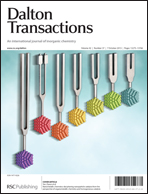Cu(i), Co(ii) and Fe(ii) coordination polymers with pyrazine and benzoate as ligands. Spin crossover, spin canting and metamagnetism phenomena†
Abstract
The isolation and characterization of four coordination polymers obtained by direct reactions of metal ion salts of Cu(II), Co(II) and Fe(II) with pyrazine (pyz) and benzoic/benzoate (Bz) ligands under hydrothermal or hydrothermal microwave conditions are described. The use of copper(II) perchlorate as the starting salt allows us to obtain compounds in a selective way by changing the pH values giving rise to the formation of two 3D-coordination polymers: [Cu(pyz)2]ClO4·pyz (1) and [Cu2(pyz)4](ClO4)2·HBz·H2O (2). In both polymers, 4-connected Cu(I) uninodal coordination networks with significant structural differences between them, due to the templating effect of the solvation molecules and counterions, have been found. However, reactions carried out under similar conditions with MSO4 (M = Co and Fe) led to the isolation of two [M2(μ-Bz)2(μ-pyz)2(Bz)2]·(HBz) isostructural infinite 1D ladder chains (M = Co (3) and M = Fe (4)). These coordination polymers show a spin-canting antiferromagnetism and metamagnetism behaviour for Co(II) and HS ↔ HS/LS ↔ LS spin-crossover phenomena for Fe(II), respectively. The latter compound is the first example of a FeIIO4N2 coordination environment showing this phenomenon.


 Please wait while we load your content...
Please wait while we load your content...